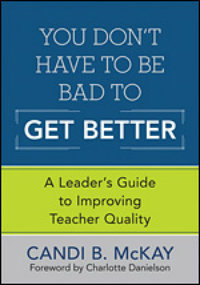Leading Teachers to Improve
You Don’t Have to Be Bad to Get Better: A Leader’s Guide to Improving Teacher Quality
By Candi B. McKay
(Corwin Press, 2013 – Learn more)

Candi McKay leaves no doubt about why she wrote You Don’t Have to Be Bad to Get Better: “The central purpose of this book is to describe the attributes of school leaders that enable them to improve the quality of teaching and learning.” (Preface, page xi) And she does an excellent job of addressing the tough issues of instructional leadership, teacher quality, and student achievement in the next 122 pages.
McKay was spot-on in Chapter One when she advises school leaders to “remove their rose-colored glasses and examine their role as instructional leaders.” Drawing from her experiences as a national consultant, McKay says it is tough for some principals “to have conversations about learning with teachers.” In her work with schools, McKay reports that the principal often jumps to the defense of teachers with comments like “they are working very hard.” (After reading Chapter One, I suggest a school leader reflect on the professional path he/she took to his/her current position.)

Everyone is able to learn and grow
McKay suggests that the mindset of both school leaders and teachers must change so that folks don’t believe you have to be bad to get better. “To improve the quality of teaching, leaders must believe in the competence and instructional capacity of their staff, and that staff members are able to learn and grow.” (p. 27)
I found McKay’s suggestions and ideas for working with a school both manageable and nonthreatening. For example, her recommended activity, “A Process for Capturing School History” (pp.37 – 38), will give a school staff a better understanding of their past, so they can better plan for the future. Again, she leaves no doubt about what she is looking for in school leadership: someone who walks the walk, not just talks the talk.
Chapter Three required a slow, meticulous read; it’s packed with information, ideas, and suggestions to improve the quality of teaching. Throughout this chapter and the entire book, McKay reminds us that teachers and leaders must agree on what constitutes good teaching and how learning occurs.
The final section in each of the six chapters, “Putting Words Into Action,” includes a reflection activity and an action tool (e.g., Daily Tracker, In Search of Evidence, Listening Skills Inventory, etc.). I was disappointed that these useful tools were not available as reproducibles for download at the Corwin site.
You Don’t Have to Be Bad to Get Better is a practical, easy-to-read handbook for school leaders. And McKay’s anecdotes are well-placed, underscoring the value of professional conversation and reflection about what effective teaching is.
Thanks to Candi McKay for providing both school and district level leadership with a plan to get better! A principal who wants to see improved student achievement in his/her building should read, study, and implement the ideas laid out in this book.
Anne Anderson finally got out of the 8th grade after 24 years and 9 weeks! She spent the next nine years sharing her expertise in literacy and writing with K-12 teachers and administrators throughout the district. She credits National Writing Project and Poetry Alive! as turning points in her growth as a teacher. Anne now shares her expertise nationwide as an educational consultant and through her bi-monthly newsletter Spotlight on Success.






























